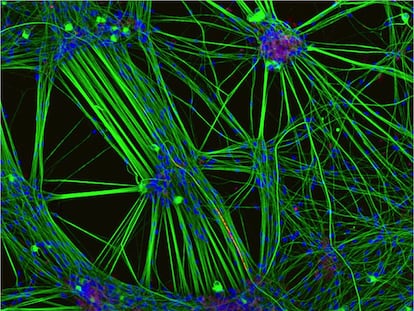Keys to avoid diagnosing false positives for ADHD
Nowadays, many children who are fidgety or too active are misdiagnosed; experts recommend consulting qualified specialists

In recent years, there has been some controversy surrounding the overdiagnosis of Attention Deficit Hyperactivity Disorder (ADHD), a neurodevelopmental disorder that manifests through symptoms like difficulty sustaining attention, motor hyperactivity and impulsivity. Inmaculada Moreno García, professor at the University of Seville and author of the book Niños hiperactivos: Cómo ayudar a los padres a afrontar los problemas de conducta (Hyperactive children: How to help parents deal with conduct problems), claims that many of the children diagnosed do not actually suffer from it; she considers that measures must be tightened and professionals should be cautious when identifying and diagnosing minors, refraining from acting out of social pressure or compelled by the parents’ demand.
Socially, the concept of hyperactivity has become generalized. However, claiming that someone suffers from it, for the specialist, is hasty and causes its clinical nature to be ignored. “We know of cases where school staff has told parents that their child may be hyperactive while, in fact, they don’t meet the criteria for the diagnosis. The fidgeting and restlessness that adults notice often have to do with age,” says Moreno García, who adds that labeling a child can be difficult to undo in the long run.
According to the fifth edition of the Diagnostic and Statistical Manual of Mental Disorders (DSM-5), published by the American Psychiatric Association, 5% of school-age children have ADHD. The manual explains that this disorder begins in infancy and is the result of instability in the chemical levels of the brain. Its symptoms are difficulty concentrating, hyperactivity, impulsivity, difficulty recognizing and regulating emotions, low tolerance for frustration, cognitive rigidity, need for external stimuli and reinforcement, difficulty in decision-making, poor internal language, low self-motivation, little perseverance and more. These symptoms can affect the daily life of the child for at least six straight months.
“My group carried out a study with the University of the Balearic Islands and with the collaboration of the Andalusian Health Service of Seville [...] that revealed that approximately 40% of the cases diagnosed as ADHD in primary care are false positives. In other words, 4 out of 10 children are diagnosed without meeting all the criteria identified for this disorder,” emphasizes Moreno García. Referring children to more specialized services and employing other, more rigorous resources and instruments, this percentage decreases, she points out.
A diagnosis that should be taken seriously
To date, explains Moreno García, there is no single, unique marker (be it biological, electroencephalographic, behavioral or psychological) that by itself identifies ADHD. In some cases, when the pediatrician’s diagnosis arrives, an unnecessary pharmacological treatment has already been prescribed, or psychological therapy or support classes have been recommended, while the child does not really need them.
“This disorder has a peculiarity which is that its core symptoms (motor overactivity, impulsivity, attention deficit) are common at a certain stage of development. To attribute hyperactivity to a child, attention must be paid to dysfunction, problems in the minor’s daily life, conflicts with parents, trouble with classmates at school, or with teachers, or social isolation,” asserts the education expert.
Health psychologist Marta Márquez adds that the educational and health systems have many gaps in this field: for a child to be diagnosed as ADHD it must be stated – in writing – by professionals such as a clinical psychologist, a child psychiatrist or a neuropediatrician, not by teachers or therapeutic pedagogues, as that entails a professional intrusion. Márquez explains that when parents go to a family doctor and say that their child does not pay attention, does not obey or is very nervous, they can leave with a prescription for medications such as methylphenidate — psychostimulant substances capable of reducing the thresholds of alertness or wakefulness. “These are pills that overactivate at the brain level to counteract the symptoms of the disorder, and they do it too quickly,” she points out. This is why “psychologists have to remove, in some cases, these patients’ dependence on these substances, because in high doses they create an addiction.”
“In ADHD, a pharmacological treatment is used to replace psychological interventions, because they are more expensive. But treating the child in therapy is better and allows healing. Add to this the lack of conciliation and that many parents come home from work tired and without patience to raise their children,” adds the psychologist. As an example, Márquez mentions the cases of young children who wake up very early, attend the morning classroom, go to the school cafeteria after classes and then, without going home, go straight to their extracurricular activities, finding themselves upset throughout the day. They could be assigned a diagnosis of ADHD: “With this kind of cases, digging a little deeper, one can discover that they actually have good sustained attention and are calm people who, if given some attention, would not have certain reactions. The lack of affection also influences; not because their parents don’t love them, but because the reality of family problems is very diverse.”
Tu suscripción se está usando en otro dispositivo
¿Quieres añadir otro usuario a tu suscripción?
Si continúas leyendo en este dispositivo, no se podrá leer en el otro.
FlechaTu suscripción se está usando en otro dispositivo y solo puedes acceder a EL PAÍS desde un dispositivo a la vez.
Si quieres compartir tu cuenta, cambia tu suscripción a la modalidad Premium, así podrás añadir otro usuario. Cada uno accederá con su propia cuenta de email, lo que os permitirá personalizar vuestra experiencia en EL PAÍS.
¿Tienes una suscripción de empresa? Accede aquí para contratar más cuentas.
En el caso de no saber quién está usando tu cuenta, te recomendamos cambiar tu contraseña aquí.
Si decides continuar compartiendo tu cuenta, este mensaje se mostrará en tu dispositivo y en el de la otra persona que está usando tu cuenta de forma indefinida, afectando a tu experiencia de lectura. Puedes consultar aquí los términos y condiciones de la suscripción digital.
More information
Últimas noticias
NASA discovers Titan doesn’t have an ocean, but a ‘slushy ice layer’ that increases possibility of life
Innocence lost in the forest of the child soldiers: ‘Each leader of the armed group had his girls’
‘Fallout’ or how the world’s largest company turned an anti-capitalist apocalyptic Western into a phenomenon
From inflation to defending migrants: Eileen Higgins and Zohran Mamdani inaugurate the new Democratic resistance against Trump
Most viewed
- Christian Louboutin: ‘Young people don’t want to be like their parents. And if their parents wear sneakers, they’re going to look for something else’
- ‘El Limones’ and the growing union disguise of Mexican organized crime
- The low-cost creative revolution: How technology is making art accessible to everyone
- ‘We are dying’: Cuba sinks into a health crisis amid medicine shortages and misdiagnosis
- Liset Menéndez de la Prida, neuroscientist: ‘It’s not normal to constantly seek pleasure; it’s important to be bored, to be calm’











































